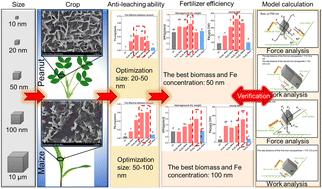当前位置:
X-MOL 学术
›
Environ. Sci.: Nano
›
论文详情
Our official English website, www.x-mol.net, welcomes your
feedback! (Note: you will need to create a separate account there.)
Optimal size of Fe3O4 nanoparticles for different crops depends on the unique nanoscale microstructure of plant leaves under rainy conditions
Environmental Science: Nano ( IF 5.8 ) Pub Date : 2024-11-07 , DOI: 10.1039/d4en00753k Lingyun Chen, Wanru Qing, Xiaoxiao Li, Wenhui Chen, Can Hao, Dunyi Liu, Xinping Chen
Environmental Science: Nano ( IF 5.8 ) Pub Date : 2024-11-07 , DOI: 10.1039/d4en00753k Lingyun Chen, Wanru Qing, Xiaoxiao Li, Wenhui Chen, Can Hao, Dunyi Liu, Xinping Chen

|
Metal-based nanoparticles (NPs) have garnered attention as a potential micronutrient nano-fertilizer. Most studies have focused on the effects of individual NP size on environmental risks and the uptake, translocation, and biological progress of NPs in plants. However, there is a lack of research on the effects of NPs of different sizes and their interactions with the nanoscale layers of plant leaves (hereafter, nanosheets), which may affect adhesion ability, anti-leaching properties, release rate, and fertilizer efficiency. In this study, various sizes (10, 20, 50, 100 nm, and 10 μm) of Fe3O4-NPs (Fe3O4-NPs) were applied to peanut (Fe strategy I, dicotyledon) and maize (Fe strategy II, monocotyledon) leaves to quantitatively compare their fertilization efficiency and anti-leaching effects. The optimal size for different crop leaves differed due to the distinct microstructures of the nanosheets on the leaf surface. In peanut, the optimal size was 50 nm, resulting in superior dry weight (1.32 g per plant), leaf iron concentration (483 μg g−1 DW), and adhesion amount (0.039 mg per plant). For maize, the optimal size was found to be 100 nm, leading to increased dry weight (1.98 g per plant), leaf iron concentration (258 μg g−1 DW), and adhesion amount (0.061 mg per plant). A model was developed to simulate the force and work exerted by Fe3O4-NPs of different sizes on leaf nanosheets, resulting in the optimal size consistent with the experimental findings. These findings will guide the selection of the optimized NP size for different leaves, thereby enhancing the efficiency of nano-fertilizer utilization and facilitating the development of new types of nano-fertilizers.
中文翻译:

不同作物的 Fe3O4 纳米颗粒的最佳尺寸取决于植物叶片在雨天条件下独特的纳米级微观结构
金属基纳米颗粒 (NPs) 作为一种潜在的微量营养素纳米肥料而受到关注。大多数研究都集中在单个 NP 大小对环境风险以及植物中 NP 的吸收、转运和生物进展的影响。然而,目前还缺乏关于不同大小的 NPs 的影响及其与植物叶片纳米级层(以下简称纳米片)相互作用的研究,这可能会影响粘附能力、抗浸出性能、释放速率和肥料效率。本研究将不同大小(10、20、50、100 nm 和 10 μm)的 Fe3O4-NPs (Fe3 O4-NPs) 应用于花生 (Fe 策略 I,双子叶植物) 和玉米 (Fe 策略 II,单子叶植物) 叶片,定量比较它们的施肥效率和抗淋溶效果。由于叶片表面纳米片的微结构不同,不同作物叶片的最佳尺寸不同。在花生中,最佳尺寸为 50 nm,导致优异的干重(每株 1.32 g)、叶片铁浓度 (483 μg g-1 DW) 和粘附量 (每株 0.039 mg)。对于玉米,发现最佳尺寸为 100 nm,导致干重增加(每株 1.98 g)、叶片铁浓度 (258 μg g-1 DW) 和粘附量 (每株 0.061 mg)。开发了一个模型来模拟不同尺寸的 Fe3O4-NPs 对叶片纳米片施加的力和功,从而得到与实验结果一致的最佳尺寸。 这些发现将指导选择不同叶片的最佳 NP 大小,从而提高纳米肥料的利用效率,促进新型纳米肥料的开发。
更新日期:2024-11-08
中文翻译:

不同作物的 Fe3O4 纳米颗粒的最佳尺寸取决于植物叶片在雨天条件下独特的纳米级微观结构
金属基纳米颗粒 (NPs) 作为一种潜在的微量营养素纳米肥料而受到关注。大多数研究都集中在单个 NP 大小对环境风险以及植物中 NP 的吸收、转运和生物进展的影响。然而,目前还缺乏关于不同大小的 NPs 的影响及其与植物叶片纳米级层(以下简称纳米片)相互作用的研究,这可能会影响粘附能力、抗浸出性能、释放速率和肥料效率。本研究将不同大小(10、20、50、100 nm 和 10 μm)的 Fe3O4-NPs (Fe3 O4-NPs) 应用于花生 (Fe 策略 I,双子叶植物) 和玉米 (Fe 策略 II,单子叶植物) 叶片,定量比较它们的施肥效率和抗淋溶效果。由于叶片表面纳米片的微结构不同,不同作物叶片的最佳尺寸不同。在花生中,最佳尺寸为 50 nm,导致优异的干重(每株 1.32 g)、叶片铁浓度 (483 μg g-1 DW) 和粘附量 (每株 0.039 mg)。对于玉米,发现最佳尺寸为 100 nm,导致干重增加(每株 1.98 g)、叶片铁浓度 (258 μg g-1 DW) 和粘附量 (每株 0.061 mg)。开发了一个模型来模拟不同尺寸的 Fe3O4-NPs 对叶片纳米片施加的力和功,从而得到与实验结果一致的最佳尺寸。 这些发现将指导选择不同叶片的最佳 NP 大小,从而提高纳米肥料的利用效率,促进新型纳米肥料的开发。


















































 京公网安备 11010802027423号
京公网安备 11010802027423号